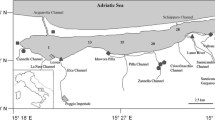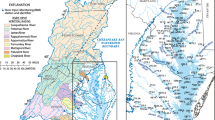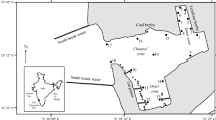Abstract
Phytoplankton is one of the biological quality elements included in the EU Water Framework Directive (WFD). Classification of water quality according to the WFD is based on the deviation of the present conditions from reference conditions. Given the lack of data from pristine conditions, this study used approximately 100-year-old measurements of Secchi depths from Danish waters in combination with relationships between Secchi depth and chlorophyll a (as a proxy for phytoplankton biomass) obtained from recent monitoring to calculate ‘historical’ or reference chlorophyll a (Chl-a) concentrations. Historical Secchi depth data were available for 9 out of the 11 Danish WFD intercalibration sites. At eight of the sites, reference summer (May–September) Chl-a concentrations were in the range 0.7–1.2 μg l−1. At one site, west of Bornholm in the western Baltic Sea, historical Secchi depth measurements date back to only the late 1950s corresponding to a calculated Chl-a concentration of 1.3 μg l−1. This value cannot be considered representative of reference conditions.
Similar content being viewed by others
Avoid common mistakes on your manuscript.
Phytoplankton is one of the Water Framework Directive (WFD) biological quality elements. The classification of water quality by means of phytoplankton should be based on phytoplankton biomass, composition, and abundance and, in addition, phytoplankton blooms frequency and intensity. For all of these phytoplankton parameters, the deviation from reference or undisturbed conditions is a measure of the water quality.
Danish waters have been heavily impacted by human activity for a long time. Thus, it is not possible to obtain reference conditions from data obtained from the present marine-monitoring programs, which were generally initiated during the 1970s or later. Some early records of phytoplankton from Danish waters are available (e.g., Petersen, 1903; Ostenfeld, 1913). However, the phytoplankton data presented are qualitative, or at best semi-quantitative, and collected using plankton net samples rather than modern techniques, thus precluding a direct comparison with recent data.
In contrast to data on phytoplankton parameters, a number of approximately 100-year-old measurements of Secchi depth are available for Danish waters. Secchi depth, or water clarity, is dependent on the abundance or biomass of phytoplankton, commonly expressed by the concentration of Chl-a, present in the water. However, the relationship between phytoplankton Chl-a and Secchi depth is not linear owing to the influence of, for example, suspended particles and dissolved organic matter (DOM) on the water transparency (Kirk, 1994).
This study aimed at establishing preliminary reference conditions for phytoplankton biomass, expressed as Chl-a, using historical Secchi depth measurements and relationships between Secchi depth and Chl-a obtained from recent monitoring data from the geographical areas included as Danish sites in the EU WFD intercalibration. Due to the long history of human activity and dense population in Denmark, conditions 100 years ago cannot be considered pristine. However, data from this time period represent the oldest pelagic measurements available and inputs of nutrients to the marine areas were minor in comparison to the post-World War Two period of intensified agriculture and use of fertilizers.
Data on Secchi depth and Chl-a concentrations (in 1 m depth) were collected from the Danish intercalibration sites (Fig. 1) as part of the Danish National Aquatic Monitoring and Assessment Programme (Conley et al., 2002). While comparison of Secchi depth with Chl-a concentrations in integrated samples representing a large part of the upper water column would be optimal, a comparison with samples taken at 1 m depth was chosen to follow procedures determined for the EU WFD intercalibration. For each intercalibration site, data from several monitoring stations were included. Time periods covered by the monitoring program are shown in Table 1.
Top panel WFD intercalibration sites in Danish waters where Chl-a and Secchi depth data are available. 1: Inner Wadden Sea, 2: Outer Wadden Sea, 3: Hirtshals, 4: Northern Kattegat, 5: Århus Bay, 6: North of Funen, 7: Dybsø Fjord, 8: Hjelm Bay, 9: Fakse Bay, 10: Northern and central part of the Sound, 11: West of Bornholm. Each intercalibration site includes several monitoring stations. Bottom panel Historical Secchi depth measurements from Danish waters (Aarup, 2002). Each marker may represent several measurements
Secchi depth measurements taken from Danish waters during the early 1900s (Aarup, 2002; data available from the ICES database at http://www.ices.dk/Ocean/project/secchi/) were used for comparison with the relationships found in recent monitoring data. The geographical distribution of these measurements is shown in Fig. 1. In addition, series of Secchi depth measurements taken from lightships in northern Kattegat and in the Great Belt during the 1960s and 1970s were available for comparison with recent data (Table 1).
For all intercalibration sites, recent monitoring data were used to establish Secchi depth–Chl-a relationships (Fig. 2). In addition to Chl-a, suspended particles and DOM will affect light absorption in the water column and thus Secchi depth (Kirk, 1994). Therefore, the relationships between Secchi depth and Chl-a showed a very large scatter with a range of Chl-a values corresponding to each Secchi depth, in particular at the numerically low Secchi depths. To compensate for the lack of complementary data on factors other than Chl-a that influence Secchi depth, relationships were established using boundary functions describing the upper bounds of the distributions (Blackburn et al., 1992; Krause-Jensen et al., 2000). The rationale behind this approach was that the higher the Chl-a values at an individual Secchi depth, the higher the contribution from Chl-a to the total light attenuation and thereby influence on Secchi depth. Furthermore, analyses were only performed on summer samples (May–September) to reduce the likelihood of strong wind events, which potentially lead to heavy resuspension of sediment. During this time period, the growth of phytoplankton is predicted to be limited by the availability of nutrients rather than light, and Chl-a is expected to be a major contributor to light attenuation in the water column.
Corresponding summer (May–September) values of Secchi depth and Chl-a concentration at the EU WFD intercalibration site Århus Bay. The regression model is based on 90th percentile values of Chl-a within 1-m Secchi depth intervals. Additional markers indicate historical Secchi depth measurements from Aarup (2002); these markers of historical Secchi depths are placed on the x-axis as no corresponding Chl-a values were available
In shallow areas where the cover and depth limit of benthic vegetation has changed from the time of the historical Secchi depth measurements until now, the contribution from resuspended particles to total water column light attenuation may have changed. Such potential changes have not been included in this study.
Corresponding measurements of Chl-a concentrations and Secchi depths were grouped in bins representing 1 m Secchi depth intervals. For each 1-m Secchi depth interval, the 90th percentile of the corresponding Chl-a measurements was calculated. Subsequently, correlations between the average depth of each Secchi depth bin (0.5 m, 1.5 m, 2.5 m, etc.) and the 90th percentiles of Chl-a concentrations were established from regression analyses assuming exponential relationships (Fig. 2).
For all intercalibration sites, a significant correlation was found between the Secchi depth and the 90th percentiles of Chl-a concentrations found within each Secchi depth interval (Fig. 2). For areas with historical Secchi depth data, ‘historical Chl-a values’ were calculated using the 90th percentile correlations and averages of the historical Secchi depth measurements (Tables 1, 2). Thus, the calculated ‘historical’ Chl-a values represent estimates of the 90th percentile in the historical data. ‘Historical’ summer averages were calculated from the ‘historical’ 90th percentiles assuming a similar ratio between averages and 90th percentiles in historical and recent (monitoring) data (Table 3).
Historical Secchi depths used for the Hirtshals and outer Wadden Sea intercalibration sites originated further offshore than the intercalibration sites. Based on Aarup (2002), historical Secchi depths from these two sites were assumed to have been approximately 75% and 65%, respectively, of the offshore values.
For all areas, the calculated historical Chl-a concentrations were lower than recent values. Thus, the averages of recent (2000–2005) Chl-a measurements were from 1.2-fold (North of Funen) to 5.4-fold (outer Wadden Sea) higher than the calculated historical values. The historical Secchi depth measurements available for the area north of Funen ranged from 7 to 10 m (Table 1). However, data on the depth limit of eelgrass (Zostera marina) from the same area and time period showed the growth of eelgrass down to approximately 10.4 m depth (Ostenfeld, 1908). Thus, the few (five) historical Secchi depth measurements available for that area seem to underestimate the Secchi depth resulting in too high a Chl-a reference condition for that area. This is further supported by the much deeper ‘historical’ Secchi depths in Århus Bay (Table 1) located close to the area north of Funen and a general similarity in the calculated Chl-a reference conditions for the other intercalibration sites showing similar Secchi depth–Chl-a relationships (northern Kattegat, northern part of the Sound, Hjelm Bay and Fakse Bay, Table 1). Using the relation between depth limit of eelgrass and Secchi depth given by Nielsen et al. (2002), a depth limit of 10.4 m would correspond to a Secchi depth of 12.8 m and subsequently a ‘historical’ average Chl-a concentration of 1.2 μg l−1. This value is in better agreement with reference values from the other sites in the Kattegat area and is therefore suggested as a better estimate of Chl-a reference conditions north of Funen (Tables 2, 3).
Secchi depth measurements obtained from lightships in the northern Kattegat and the Great Belt during the 1960s and 1970s illustrate a reduction in water clarity from about 1900 until the 1960s and a further reduction from the 1960s until the 1970s (Table 2). Data from the intercalibration sites show that water clarity has improved since the 1980s and present conditions in the northern Kattegat are comparable to those in the 1970s (Table 2). Eutrophication leading to increased biomass of phytoplankton is expected to be a major cause for the changed Secchi depth regimes. While Chl-a measurements are available only from the 1980s and onwards, the early measurements of primary production made by Steemann Nielsen in the Kattegat during the 1950s support the hypothesis that the reduced water clarity is coupled to eutrophication. Thus, Richardson & Heilmann (1995) calculated a two to threefold increase in primary production in the Kattegat from the 1950s until the period 1984–1993.
Historical Secchi depth measurements were not available for the northern part of the Sound. A modeled ‘pristine’ scenario for the Sound (Øresundsvandsamarbejdet, 2004) suggested that recent summer (June–August) Chl-a concentrations are approximately 75–90% higher than those 150 years ago. Assuming a similar development for the period May–September and a 70% increase over the last century, it is possible to estimate a ‘historical’ average Chl-a concentration of 0.9 μg l−1 for this area.
No historical data were available for the Dybsø Fjord or Inner Wadden Sea intercalibration sites and therefore reference conditions could not be established. At the site west of Bornholm, historical Secchi depth data date back to only the late 1950s and thus are not directly comparable to reference conditions established for the other areas.
In a recent project on the development of tools for the assessment of eutrophication in the Baltic Sea, Finland estimated the boundary between high and good ecological status according to the EU WFD as the 10th percentile of recent monitoring data (Andersen et al., 2006). For comparison, the 10th and 20th percentiles of the Chl-a measurements from the monitoring programs have been included in Table 3. For most of the Danish intercalibration sites, the 10th or 20th percentiles of monitoring data were in good agreement with estimated reference conditions. However, at Hirtshals and west of Bornholm, the 10th and 20th percentiles were much lower than the estimated reference conditions, and in the outer Wadden Sea the 10th and 20th percentiles were approximately 2- and 3-fold higher than the estimated reference Chl-a concentration (Table 3). It should be emphasized that even though the 10th or 20th percentile method showed reasonable agreement with estimated reference Chl-a concentrations at several of the Danish intercalibration sites, this approach should not be taken in more enclosed and heavily eutrophied areas where all recent Chl-a measurements will be expected to exceed reference conditions.
This study provides a first step in establishing reference conditions for phytoplankton in Danish waters. Chl-a is the most commonly used proxy for phytoplankton biomass and it was chosen as the first phytoplankton metric for the EU WFD intercalibration process. However, in addition to Chl-a, phytoplankton species composition, abundance, and bloom frequency/intensity should be included in the future assessment of water quality. At present, reference conditions are not available for these indicators.
References
Aarup, T., 2002. Transparency of the North Sea and Baltic Sea—a Secchi depth data mining study. Oceanologia 44: 323–337.
Andersen, J. H., J. Aigars, U. Claussen, B. Håkanson, H. Karup, M. Laamanen, E. Lysiak-Pastuszak, G. Martin & G. Nausch, 2006. Development of tools for assessment of eutrophication in the Baltic Sea. Baltic Sea Environment Proceedings No. 104, Helsinki Commission.
Blackburn, T. M., J. H. Lawton & J. N. Perry, 1992. A method of estimating the slope of upper bounds of plots of body size and abundance in natural animal assemblages. Oikos 65: 107–112.
Conley, D. J., S. S. Markager, J. Andersen, T. Ellermann & L. M. Svendsen, 2002. Coastal eutrophication and the Danish national aquatic monitoring and assessment program. Estuaries 25: 706–719.
Kirk, T. O., 1994. Light and photosynthesis in aquatic ecosystems. Cambridge University Press, London.
Krause-Jensen, D., A. L. Middelboe, K. Sand-Jensen & P. B. Christensen, 2000. Eelgrass, Zostera marina, growth along depth gradients: upper boundaries of the variation as a powerful predictive tool. Oikos 91: 233–244.
Nielsen, S. L., K. Sand-Jensen, J. Borum & O. Geertz-Hansen, 2002. Depth colonisation of eelgrass (Zostera marina) and macroalgae as determined by water transparency in Danish coastal waters. Estuaries 25: 1025–1032.
Øresundsvandsamarbejdet, 2004. Jämförelse mellan “urtida” och “nutida” näringsnivåer i Öresund.—beräkninger utförda med MIKE 3-modell. Öresundsvattensamarbetet, http://www.oresundsvand.dk (in Swedish).
Ostenfeld, C. H., 1908. Ålegræssets (Zostera marina’s) udbredelse i vore farvande. In Petersen, C. G. J. (ed.), Beretning til Landbrugsministeriet fra den danske biologiske station XVI. Centraltrykkeriet, Copenhagen: 1–61 (in Danish).
Ostenfeld, C. H., 1913. De danske Farvandes Plankton i Årene 1889–1901. Phytoplankton og protozooer I. Kgl. Danske Vidensk. Selsk. Skr. 7. Række. Naturv. og Math. Afd. IX. 2: 1–478 (in Danish).
Petersen, C. G. J., 1903. De danske Farvandes Plankton i Årene 1898–1901. Kgl. Danske Vidensk. Selsk. Skrifter, 6. Række. Naturv. og Math. Afd. XII.3. Bianco Lunos Bogtrykkeri. Kjøbenhavn (in Danish).
Richardson, K. & J. P. Heilmann, 1995. Primary production in the Kattegat: past and present. Ophelia 41: 317–328.
Author information
Authors and Affiliations
Corresponding author
Additional information
Guest editors: J. H. Andersen & D. J. Conley
Eutrophication in Coastal Ecosystems: Selected papers from the Second International Symposium on Research and Management of Eutrophication in Coastal Ecosystems, 20–23 June 2006, Nyborg, Denmark
Rights and permissions
About this article
Cite this article
Henriksen, P. Reference conditions for phytoplankton at Danish Water Framework Directive intercalibration sites. Hydrobiologia 629, 255–262 (2009). https://doi.org/10.1007/s10750-009-9767-z
Published:
Issue Date:
DOI: https://doi.org/10.1007/s10750-009-9767-z






